If you are looking for colorful, unique-looking fish for your saltwater tank and have enough space to accommodate a medium to big tank, tang fish species is one of the best choices.
They are popular for their fascinating behavior, temperament, and stunning appearance. Some tangs are great for beginners, while others need a bit of extra attention and care, making them the perfect challenge for experienced aquarists.
The only demand of these spoiled brats is a spacious tank and good quality water. So, if you’re ready to begin an adventurous fishkeeping journey with tangs, keep reading…
What is a Tang Fish?
Tang fish belong to the Acanthuridae family and Perciformes order. The Acanthuridae family houses 6 existing genera and over 80 species, including surgeonfishes, unicorn fishes, and tangs.
This fish family name, Acanthuridae, originates from the Greek words “akantha” (thorn) and “oura” (tail). This led to their nickname surgeonfishes because all of them have sharp spines beside their tails, akin to surgical blades.
In fact, these spines can cause deep cuts resembling those made by a scalpel. Originally, the term “tang” referred to a snake’s tongue, once thought to be a stinging organ.
Tangs are found in tropical and subtropical waters across the globe – mostly Indian, Pacific, and Atlantic Oceans and the Caribbean Sea.
In the wild, they roam around coral reefs and rocky areas, contributing to the marine ecosystem by feasting on algae and small organisms. In fact, coral reefs are essential for tang fish’s health. If coral reefs die from climate change, the fish gets stressed.
These aggressive, vibrant-colored species are distinguished by their pointed snouts and sharp spines on both sides of their tails. The species mainly feed on algae and plankton and rarely consume meat.
What are the Types of Tang Fish?
1. Blue Tang (Paracanthurus hepatus)
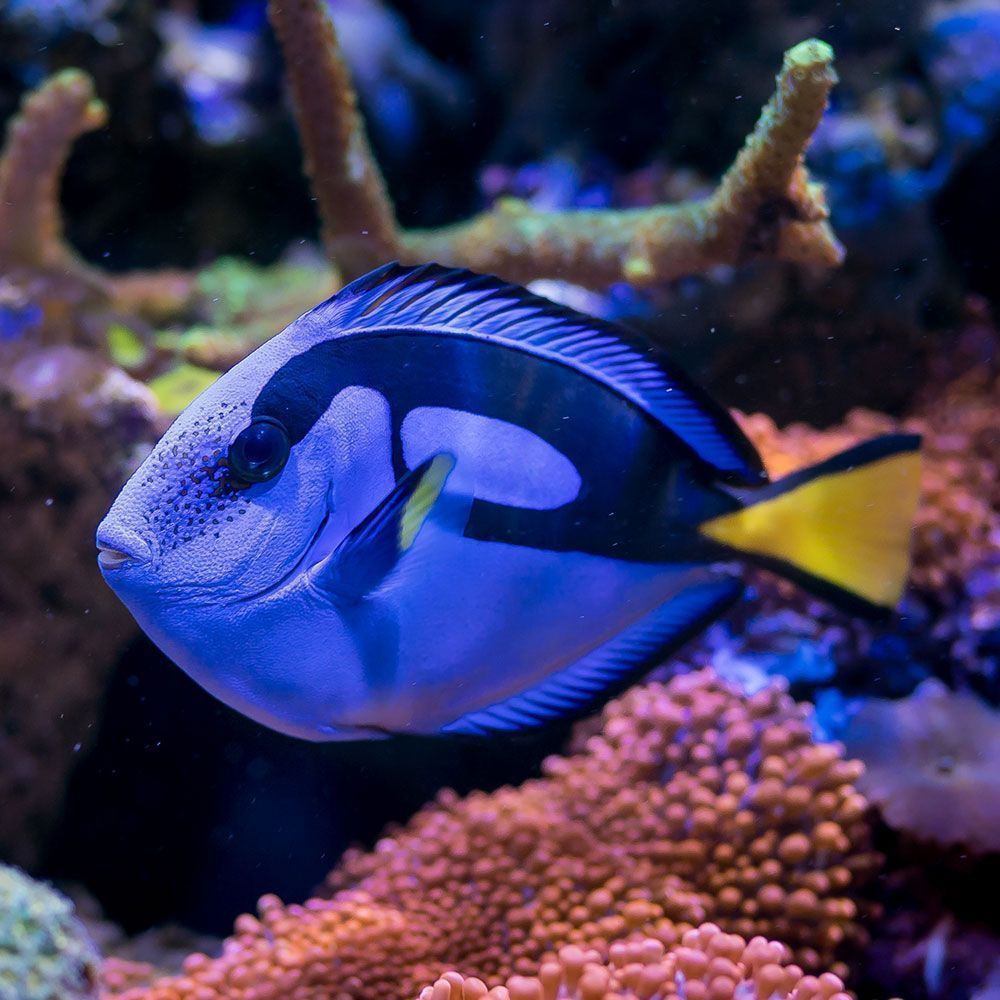
- Other Common Names: Regal tang, palette surgeonfish, royal blue tang, hippo tang, blue hippo tang, flagtail surgeonfish, pacific regal blue tang, blue surgeonfish, wedgetail blue tang, wedge-tailed tang, indo-pacific blue tang
- Average Size: Up to 30 cm (12 in)
- Average Lifespan: Up to 15-20 years in captivity, Up to 30 years in the wild
- Tank Level: All levels
- Temperament: Peaceful towards non-tangs, aggressive with conspecifics
- Diet: Omnivorous with herbivorous preferences
- Reef Safe: Yes
- Tank Mates: Similar-sized or smaller fish that can accommodate with larger tank mates, peaceful species, invertebrates
- Minimum Tank Size: 180 gallons
Blue tang has a royal blue body and yellow tail. It flaunts unique black markings, starting from the eyes down to the tail, and circles back above the pectoral fin, forming a palette-like shape. Thus, the fish is aptly named the palette surgeonfish.
Shaped like a pancake, it has a pointed snout, small scales, and a venomous caudal spine. In the species found in the West-Central Indian Ocean, its lower body is yellow.
Its color can change; juveniles are bright yellow, and stressed adults display deeper blues and violets.
In the movie Finding Nemo, Dory is a friendly blue tang. The species became more popular among saltwater aquarists after the film.
Around predators, it plays dead by going limp and lying flat horizontally in the water until the threat passes. You might see this behavior in captivity with different species, especially if it can’t find a hiding spot.
2. Yellow Tang (Zebrasoma flavescens)

- Other Common Names: Yellow sailfin tang, somber surgeonfish, lemon sailfin, yellow Hawaiian tang
- Average Size: Up to 15-20 cm (6-8 in)
- Average Lifespan: Up to 30-45 years
- Tank Level: All levels
- Temperament: Territorial as juveniles, peaceful as they mature. Aggressive towards conspecifics
- Diet: Herbivorous
- Reef Safe: Yes, with caution
- Tank Mates: Any peaceful or similar-sized slightly aggressive fish, invertebrates
- Minimum Tank Size: 150 gallons
Yellow tang fish has a narrow, oval, disc-shaped body with a slightly protruding snout and seven large dorsal and anal fins.
The fish changes color throughout the day. It’s bright yellow during the day. But at night, it turns dark, grayish-yellow with a brownish-white blotch in the middle and a white horizontal stripe.
There’s a caudal peduncle with one white spine, which is used to assert dominance or for defense. It stays folded when not in use. The spine has venom in juveniles but not in adults.
Adult males are larger than females. Other than that, males change color and show shimmering behavior during mating.
The fish secretes a protective mucus layer from its skin that wards off parasites and bacteria. This secretion also helps its body become less resistant to water, allowing it to swim faster.
In the wild, yellow tangs act as little cleaning crews for marine turtles. They remove algal growth from turtle shells, ensuring that they stay clean and healthy in the vast ocean.
3. Purple Tang (Zebrasoma xanthurum)
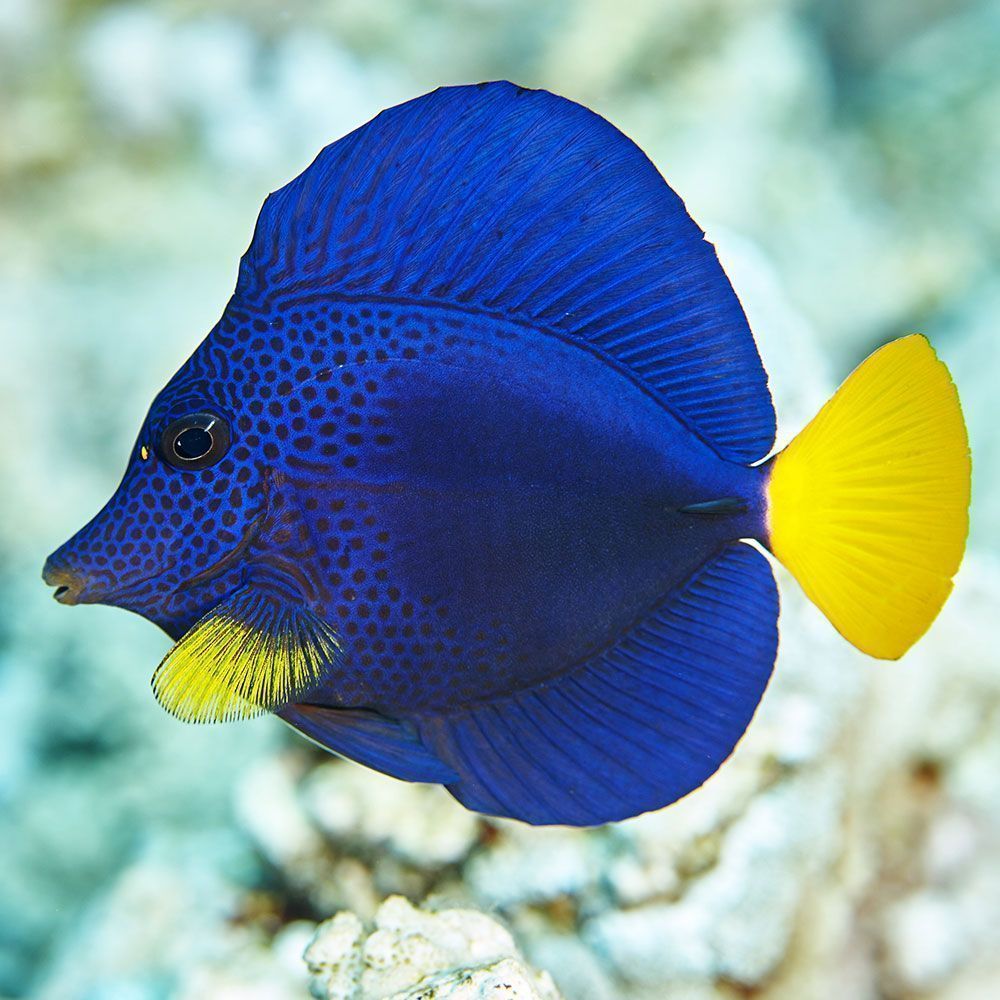
- Other Common Names: Yellowtail tang, yellowtail surgeonfish, yellowtail sailfin tang, red sea sailfin, dusky sailfin tang, blue surgeonfish
- Average Size: Varies from 10-36.7 cm (4-14.45 in)
- Average Lifespan: Around 10 years in captivity, 30-45 years in the wild
- Tank Level: All levels
- Temperament: Semi-aggressive
- Diet: Omnivorous with a more herbivorous diet
- Reef Safe: Yes
- Tank Mates: Larger, semi-aggressive fish, few invertebrates
- Minimum Tank Size: 125 gallons
Purple tang is known for its vibrant purple body and yellow tail. It has an elongated snout, black spots on its head, and some have black lines on the sides.
With large dorsal and anal fins, it resembles a disk when fins are fully extended. It has sharp spines on the slightly rounded or truncated tail for defense. There’s also a velvety bristle patch on the tail just before the spine.
Juveniles have rounded tails and horizontal stripes that fade as they grow.
The xanthurum part of its scientific name refers to its yellow tail fin.
4. Sailfin Tang (Zebrasoma velifer)
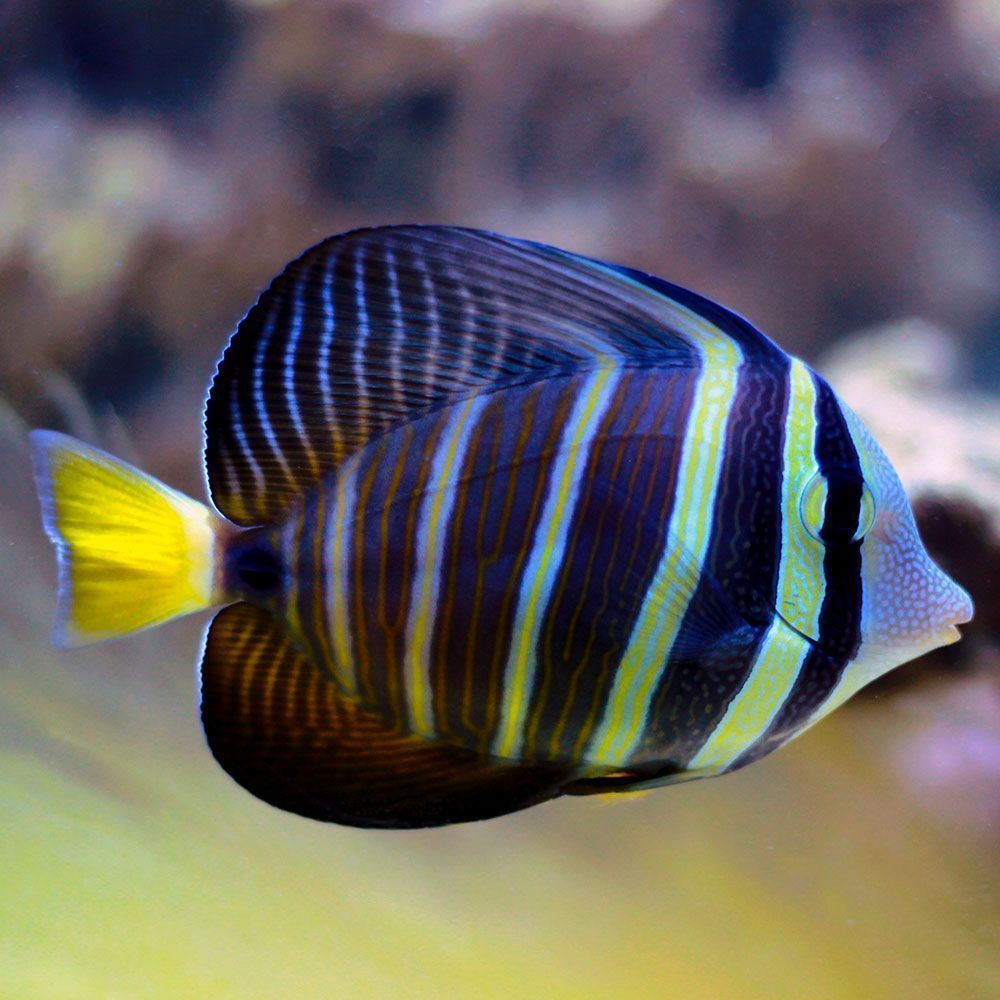
- Other Common Names: Sailfin surgeonfish, sailfish tang, ringed tang, purple-lined tang, pacific sailfin tang
- Average Size: Up to 40 cm (15.7 in)
- Average Lifespan: Up to 5 to 7 years in captivity, 30 years in the wild
- Tank Level: All levels
- Temperament: Territorial, aggressive, especially towards conspecifics
- Diet: Mostly herbivorous, can be omnivorous
- Reef Safe: Yes
- Tank Mates: Most peaceful and non-aggressive non-tang species and invertebrates
- Minimum Tank Size: 180 gallons
The sailfin tang has a deep, disc-shaped body with a raised dorsal fin, a big anal fin, and an extended white or yellow snout.
It has a yellow-dotted white head, dotted dark bands around its eye, and sharp scalpel-like spines on each side of the caudal peduncle for defense and establishing dominance.
The brown-bodied fish has yellow bands extending up to dorsal and anal fins, adorned with yellow dots.
Usually yellow with blue highlights on the edge, the tail can also be white, yellowish, or brown.
While its colors are generally dull, it can control the intensity of its markings, making them appear lighter or even darker.
In its taxon name, the specific name velifer is a combination of “velo” (meaning: sail) and “fero” (meaning: to bear). It signifies the fish’s high dorsal fin.
5. Tomini Tang (Ctenochaetus tominiensis)
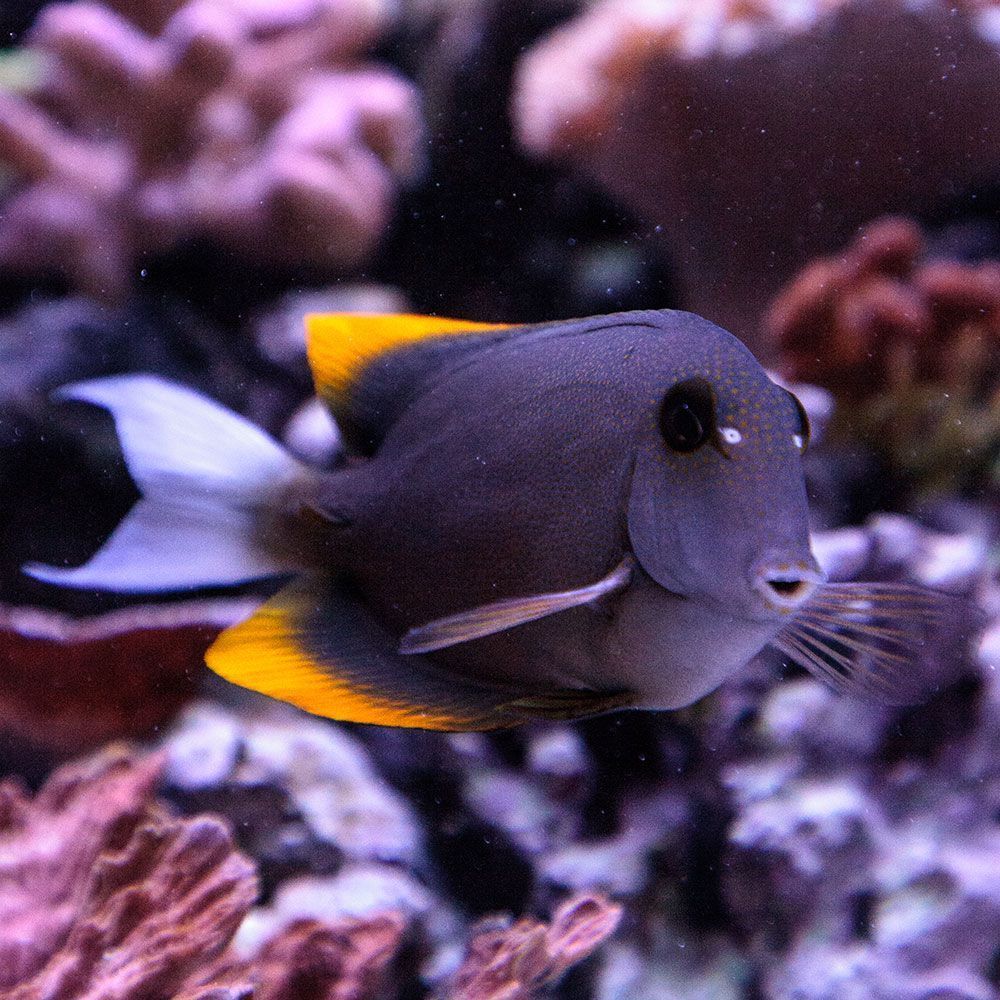
- Other Common Names: Tomini bristle tooth, yellow tip bristle tooth, orange tip bristle tooth, tomini surgeonfish, bristletooth tomini tang, flame fin tang
- Average Size: Usually up to 16 cm (6 in)
- Average Lifespan: Over 5 years
- Tank Level: Bottom dwellers
- Temperament: Peaceful but may bully species introduced after them
- Diet: Omnivorous but primarily herbivorous
- Reef Safe: Yes
- Tank Mates: Calm and peaceful fish species of similar size
- Minimum Tank Size: 125 gallons
The juvenile tomini tang is a blend of tan, yellow, and blue with a white underbelly. As it matures, the body color turns brown, the tail turns vibrant blue, and the dorsal and anal fins become golden-yellow.
Golden flecks shimmer above its eyes, complementing a half-circle of gold beneath them. The lips have warty margins. Dorsal and anal fins have angular rear ends, a distinct trait in the Ctenochaetus genus.
The juvenile sports a forked caudal fin, which transforms into a lunate shape in adults. Male and female fish look identical, although males are generally larger than females.
Tomini tangs are part of the genus Ctenochaetus, which gets its name from the distinctive dental features – cteno, meaning comb, and chaetus, meaning bristle. They have bristly, comb-like teeth, which make devouring filamentous algae and detrital material effortless.
6. Gem Tang (Zebrasoma gemmatum)

- Other Common Names: Jeweled tang, spotted tang, Mauritian tang, gem surgeonfish, gemmatum tang
- Average Size: Up to 22 cm (8.7 in)
- Average Lifespan: Up to 25-30 years in the wild, 7-10 years in captivity
- Tank Level: Middle to bottom dweller
- Temperament: Semi-aggressive and territorial, especially towards conspecifics or similar-looking fish
- Diet: Omnivorous, primarily herbivorous
- Reef Safe: Yes
- Tank Mates: Peaceful fish of similar size, other tangs only if introduced together
- Minimum Tank Size: 180 gallons
Gem tang has a dark bluish-black body with bright yellow dots. The flat, disc-like, and oval-shaped fish has a pointed snout.
It has large sail-like dorsal and anal fins, yellow pectoral fins, and a yellow tail with a clear trim on the edge. On either side of the caudal peduncle, there are spines for defense.
Sexes are indistinguishable. Juveniles are lighter and less colorful, but their colors intensify as they mature.
Gem tangs love the surge zones in Mauritius, making them tough to collect. Divers carefully bag and transport them to the nearest airport. They undergo a complex process of unbagging, rebagging, and two flights. With limited supply and high demand, the cost shoots up.
7. Powder Blue Tang (Acanthurus leucosternon)

- Other Common Names: Blue surgeonfish, powder-blue surgeonfish
- Average Size: Up to 23 cm (9 in), Max: 54 cm (21 in)
- Average Lifespan: Around 10 years in captivity, up to 40 years in the wild
- Tank Level: All levels
- Temperament: Territorial, aggressive, especially towards other tangs and smaller fish
- Diet: Omnivorous, but primarily herbivorous
- Reef Safe: Yes
- Tank Mates: Larger, peaceful fish
- Minimum Tank Size: 125 gallons
The powder blue tang has an oval-shaped body that is flattened sideways. Its sides flaunt various shades of blue, from deep cobalt to bright turquoise accented by yellow and white. The transparent dorsal and pectoral fins are highlighted in striking yellow.
This black-head fish has white mouth, throat, and anal and pelvic fins. Its face and tail are outlined in dark blue-black, creating a bold pattern. It has a sharp spine near its crescent-shaped tail, which acts as a defense mechanism.
Its small, pointed mouth resembling a beak is equipped with tiny sharp teeth, ideal for reaching into narrow spaces to find food.
Interestingly, the intensity of its blue color changes only if it gets sick.
This fish gets its scientific name Acanthurus leucosternon from its white belly. Leuco means white in Greek, and sternon means breast.
8. Achilles Tang (Acanthurus achilles)

- Other Common Names: Redtail surgeonfish, red spot surgeonfish, red-spotted surgeonfish, Achilles surgeonfish
- Average Size: Up to 26 cm (10 in)
- Average Lifespan: 7 years or more
- Tank Level: All
- Temperament: Aggressive, especially towards conspecifics and other tangs
- Diet: Herbivorous
- Reef Safe: Yes
- Tank Mates: Peaceful fish or small semi-aggressive non-tang fish
- Minimum Tank Size: 150 to 180 gallons
Achilles tang is a swift, deep-bodied fish with remarkable speed. It has a dark brownish-black hue. There are vibrant electric blue stripes around its eyes, mouth, outer edges of the continuous dorsal fin, anal fins, and chin.
There is an orange or red teardrop shape near its tail, which points towards the tail fin. This area also has a sharp spine for self-defense. Juveniles have a line instead of this teardrop shape.
The adult fish’s tail fin is dark at the base, followed by a wide orange or red vertical band trimmed in black and outlined in white.
It also has white accents near its gills and mouth and a thin line under its dorsal and anal fins. Above this white line, there’s often an orange or red stripe on its body.
Though it wasn’t officially explained, it’s believed that this fish got its name from Achilles, the legendary hero of the Trojan War, known for his exceptional strength and bravery. It’s named because of the fish’s sharp bony plates near its caudal peduncle.
9. Naso Tang (Naso lituratus)
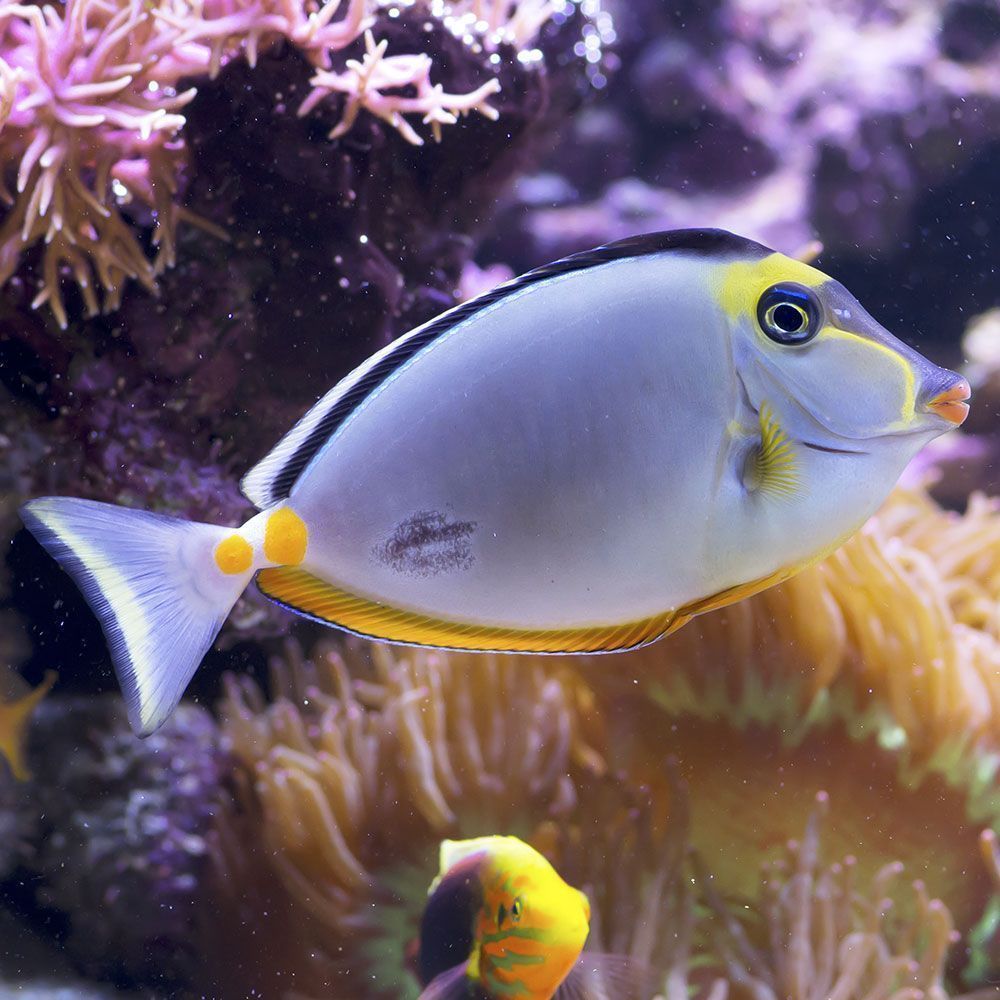
- Other Common Names: Clown unicornfish, orangespine unicornfish, black-finned unicornfish, Pacific orange-spine unicornfish, stripe-faced unicornfish, smooth-headed unicornfish, red lip surgeonfish, poll headed unicornfish, bar cheek unicornfish, lipstick tang, smooth-head unicornfish, clown tang, masked unicornfish
- Average Size: Up to 46 cm (18 in)
- Average Lifespan: Around 15-20 years, more in the wild
- Tank Level: All levels
- Temperament: Territorial and aggressive, especially towards other tangs
- Diet: Omnivorous, but primarily herbivorous.
- Reef Safe: Yes, but with caution
- Tank Mates: Non-aggressive, non-tang fish of smaller or similar size
- Minimum Tank Size: 180 gallons
Naso tang has a large light-to-dark gray body with a yellow patch on its forehead. There are accented lines below its eyes, which extend downward until the reddish-orange lips.
Dorsal fin starts blue at the base, with black and white bands on the edges. It has scalpel-like spines near the tail, surrounded by orange.
The juvenile has a dark gray with blue and orange stripes. When mature, it develops a unique lyre-shaped tail with a yellow vertical bar towards the back. It also lacks forehead horns or front protuberance seen in other Acanthuridae species.
The naso tang often gets mixed up with its close relative, the blonde naso tang (naso elegans). However, the blonde naso tang sports a yellow dorsal fin, setting it apart.
10. Scopas Tang (Zebrasoma scopas)
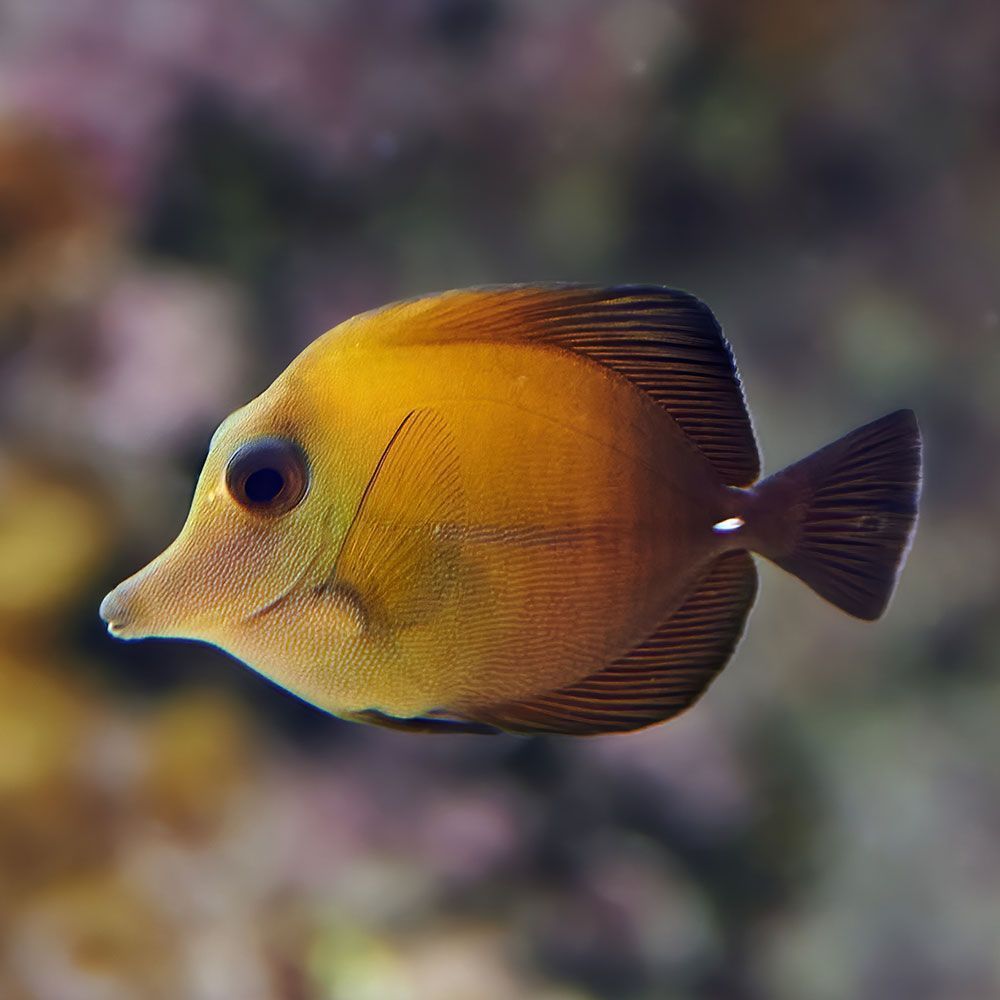
- Other Common Names: Brown tang, twotone tang, brush-tail tang, brown sailfin tang, brown sailfin surgeonfish, spotted tang, yellow tang, brown scopas tang, blue lined sailfin tang, two-tone tang
- Average Size: Usually 20-25 cm (8-10 in), Max: 40 cm (16 in)
- Average Lifespan: Up to 15 years or longer
- Tank Level: All levels
- Temperament: Semi-aggressive, especially towards conspecifics or other tangs
- Diet: Omnivorous, but primarily herbivorous
- Reef Safe: Yes
- Tank Mates: Peaceful non-tang fish of similar size
- Minimum Tank Size: 125 gallons
The round, flattened scopas tang has a pointed nose. It displays a stunning blend of colors: light greenish-yellow on the top that gradually turns darker, becoming brown towards the underside.
The body is adorned with intricate light blue dots, turning into thin bars near the brown tail.
The eye is bordered by brown, highlighted with a subtle light blue line. Juveniles are especially attractive, featuring larger dorsal and anal fins and a slightly purplish hue.
There are no visible differences between males and females.
Young scopas tangs look remarkably like sailfin tangs due to their similar white stripes running down their bodies.
11. Kole Tang (Ctenochaetus strigosus)
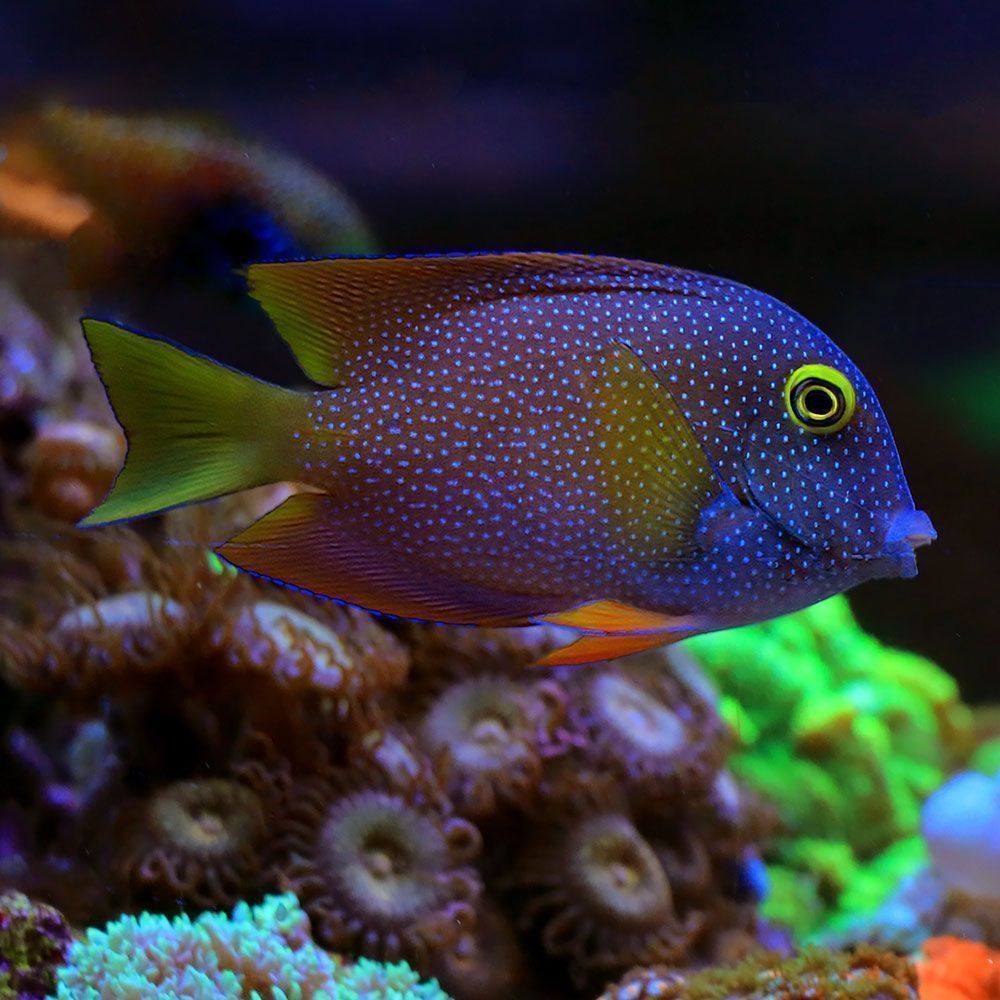
- Other Common Names: Spotted bristle tooth, spotted surgeonfish, Goldring bristle tooth, goldring surgeonfish, yellow-eyed surgeonfish, bristle-toothed surgeonfish, slender-toothed surgeonfish, Hawaiian kole tang, kole yellow eye tang
- Average Size: Up to 15 cm (6 in)
- Average Lifespan: Usually 6-10 years. Max: 25-35 years
- Tank Level: All
- Temperament: Semi-aggressive, aggressive towards all tangs
- Diet: Omnivorous, primarily herbivorous
- Reef Safe: Yes
- Tank Mates: More peaceful, non-aggressive, non-tang fish, invertebrates
- Minimum Tank Size: 75 gallons
The oval-bodied kole tang has yellow-gold to tan coloration with stripes and spots as a juvenile.
As it matures, the body darkens to a sophisticated brown shade with blue to burgundy hues, highlighting either spots or stripes, depending on its origin.
One of its most distinctive traits is the striking yellow ring around its eye. The pectoral fins feature an orange/yellowish hue, which intensifies as the fish ages.
It also possesses a spine near its tail, which it can raise when threatened. Its appearance subtly changes based on lighting conditions, with blue lighting intensifying the blue hues.
12. Clown Tang (Acanthurus lineatus)

- Other Common Names: Lined surgeonfish, blue banded surgeonfish, blue-lined surgeonfish, clown surgeonfish, pajama tang, zebra surgeonfish, spotted box crab, striped surgeon,
- Average Size: Up to 18-38 cm (7-15 in)
- Average Lifespan: Around 10 years in captivity, Max: 42 years
- Tank Level: All levels
- Temperament: Territorial and aggressive, especially with conspecifics and other tangs
- Diet: Omnivorous but primarily herbivorous
- Reef Safe: Yes, but with caution
- Tank Mates: Similar-sized non-tang fish, tangs that are different in size and shape
- Minimum Tank Size: 240 gallons
The disc-shaped clown tang boasts a vibrant yellow or orange body with contrasting light and dark blue horizontal stripes, starting around the eye and down to the tail.
Its belly is white or a paler shade of blue, and the small dorsal and anal fins have black highlights. This fish’s tail fin is rounded as juveniles and becomes forked as adults.
The female fish is slightly larger than the male fish of the same age.
The scientific name of this fish, Acanthurus lineatus, captures the essence of this fish as the word lineatus is a Latin word that translates to lined, describing its appearance.
13. Convict Tang (Acanthurus triostegus)
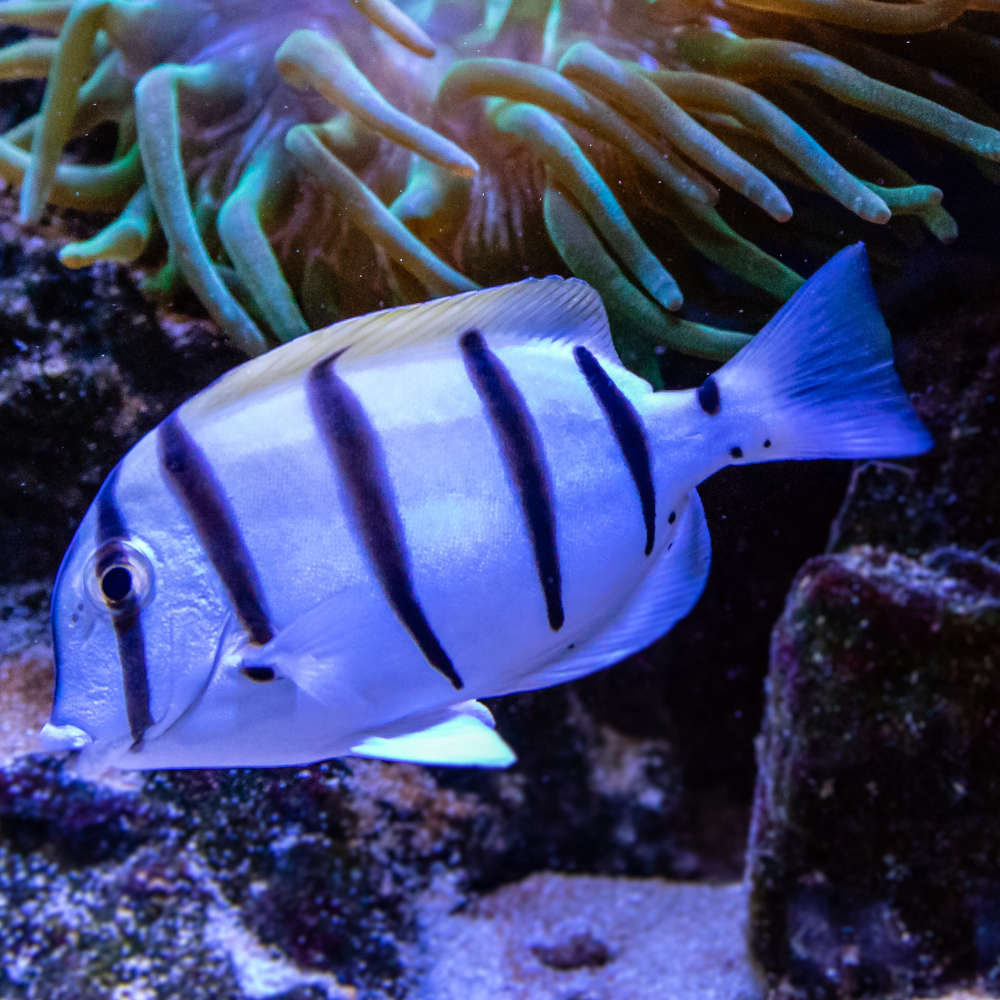
- Other Common Names: Convict surgeonfish, convict surgeon, five band surgeonfish
- Average Size: Up to 27 cm (10.6 in)
- Average Lifespan: Up to 5-7 years in captivity, 25-30 years in the wild
- Tank Level: All levels
- Temperament: Semi-aggressive, especially towards conspecifics, other tangs, and similar-shaped species
- Diet: Omnivorous, primarily herbivorous
- Reef Safe: Yes
- Tank Mates: Peaceful or semi-aggressive, different-shaped, non-tang fish
- Minimum Tank Size: 125 gallons
The oval-shaped convict tang is laterally compressed. It has a small mouth and eyes positioned high on its head.
It has a white or silver body with six black vertical stripes – five on the body and one on the head through the eye. There are peduncle spines near the tail, which are smaller compared to other tangs.
The specific name of this fish, triostegus is a Greek word that means three covers. It may refer to the fish’s three branchiostegal membranes, which are thin, flexible sheets of tissue that cover and protect the fish’s gills. These membranes serve a crucial function in the respiratory system of fish.
14. Powder Brown Tang (Acanthurus japonicus)
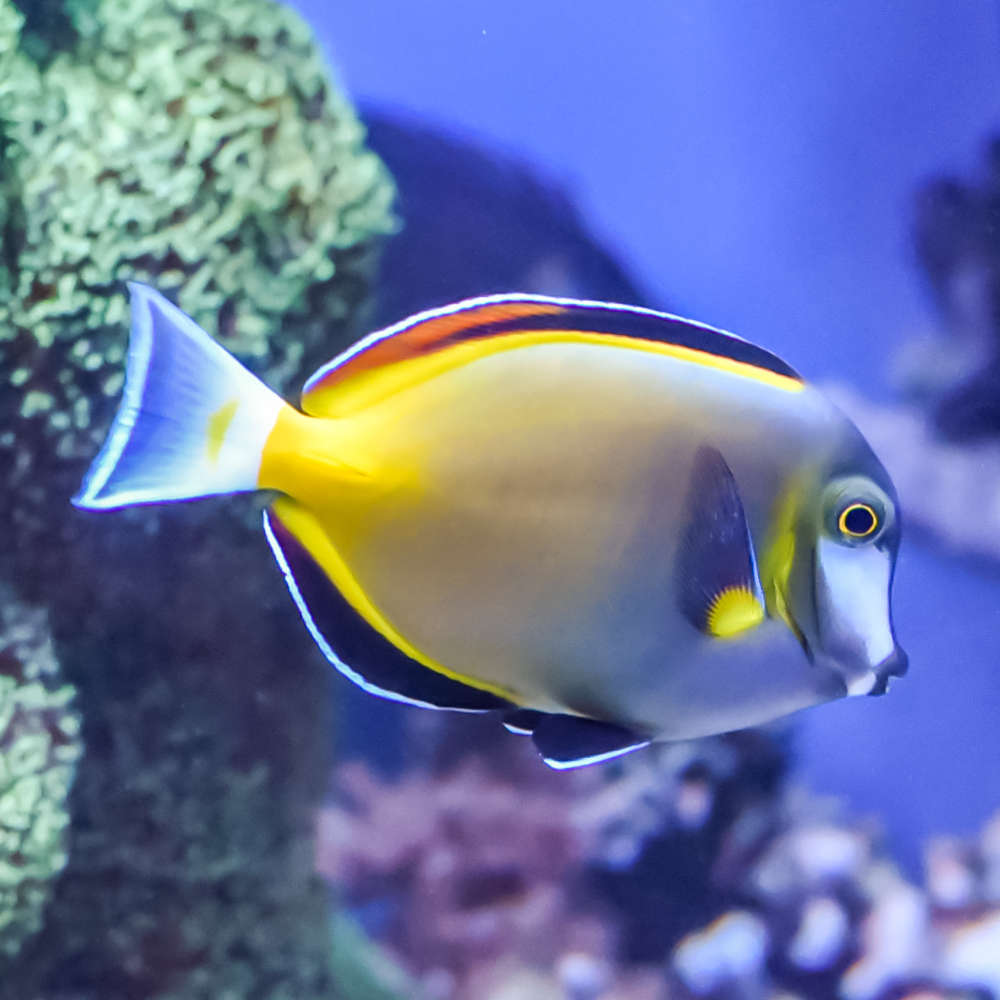
- Other Common Names: Japanese surgeonfish, powder black surgeons, white-faced surgeonfish, gold rim tang, powder brown tang, white-nose surgeonfish
- Average Size: Around 20 cm (8 in)
- Average Lifespan: Around 7 years in captivity, up to 25-30 years in the wild
- Tank Level: All levels
- Temperament: Peaceful except towards conspecifics and similar-shaped species
- Diet: Omnivorous, primarily herbivorous
- Reef Safe: Yes
- Tank Mates: Larger peaceful and non-aggressive fish, smaller semi-aggressive fish, non-tangs
- Minimum Tank Size: 125 gallons
Powder brown tang has a laterally compressed oval body with long dorsal and anal fins supported by spines and soft rays.
Its color varies from brown, diffused with blue to almost yellow as per its emotional state. It has a distinct white band from the eye to the upper lip and a wishbone-like pattern on the belly.
There’s a pink band along the soft-rayed part of its dorsal fin. The pectoral fins have yellow bases. Anal and dorsal fins are dark brown, accented by an electric-blue edge.
The caudal peduncle is black with a yellow base. Its tail fin is truncated and browner near the body, which transitions to a bluer hue near the end. The tapered points of the tailfin are sharp.
15. Orange Shoulder Tang (Acanthurus olivaceus)
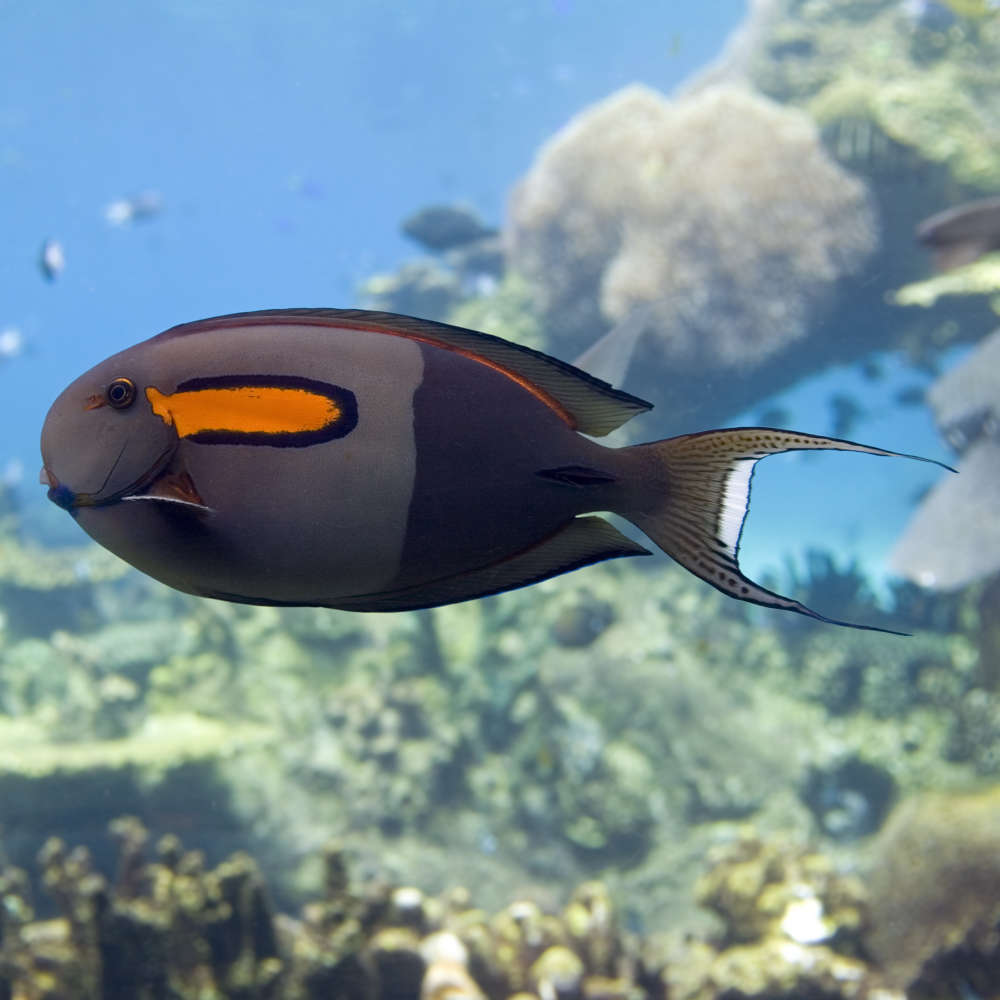
- Other Common Names: Orange-band surgeonfish, orange-shoulder surgeonfish, orange bar tang, gendarme fish, olive surgeonfish, orange epaulette surgeon, orange spot tang, orange-blotch surgeon, orange-ear surgeonfish,
- Average Size: Typically up to 25 cm (10 in), Max: 35 cm (14 in)
- Average Lifespan: 5-10 years in captivity, up to 35 years in the wild
- Tank Level: All levels
- Temperament: Peaceful
- Diet: Omnivore, primarily herbivore
- Reef Safe: Yes, with caution
- Tank Mates: Larger peaceful and non-aggressive fish, smaller semi-aggressive fish
- Minimum Tank Size: 180 gallons
The orange shoulder tang has a deep, laterally compressed, oval-shaped body. The front half is light gray, while the back half is a dark gray-blue color. The two halves are separated by a sharp vertical line.
One of the most prominent features is an eye-catching orange stripe above the pectoral fins, which is outlined by the dark gray color of the fish’s body.
Its tail has a distinctive lyre shape. Both dorsal and anal fins are long and low, extending as far as the caudal peduncle. Fin bases feature blue and orange lines.
The juvenile fish sports vibrant yellow scales with hints of blue on the anal and dorsal fins. It completely lacks the signature orange slash on its shoulder.
The orange shoulder tang’s orange slash appears around the time it reaches around 6.4 to 7.6 cm (2.5 to 3 in) in length.
A word from FishInAquarium
Tang fish species are fun and vibrant additions to your aquarium. They are also essential players in maintaining a healthy environment for reef tanks.
Just like dogs, they are aware of their owners. Along with that and their voracious appetite for algae truly make them fascinating aquatic friends.
However, it’s crucial to provide them with proper care, including ample space, clean water, and compatible tank mates. You should also handle them with caution.
If you found this information informative and helpful in understanding the world of tangs, consider sharing it with your fellow aquarists.
Feel free to email us anytime if you have questions or need further support in caring for your tang fish. Happy fishkeeping!

